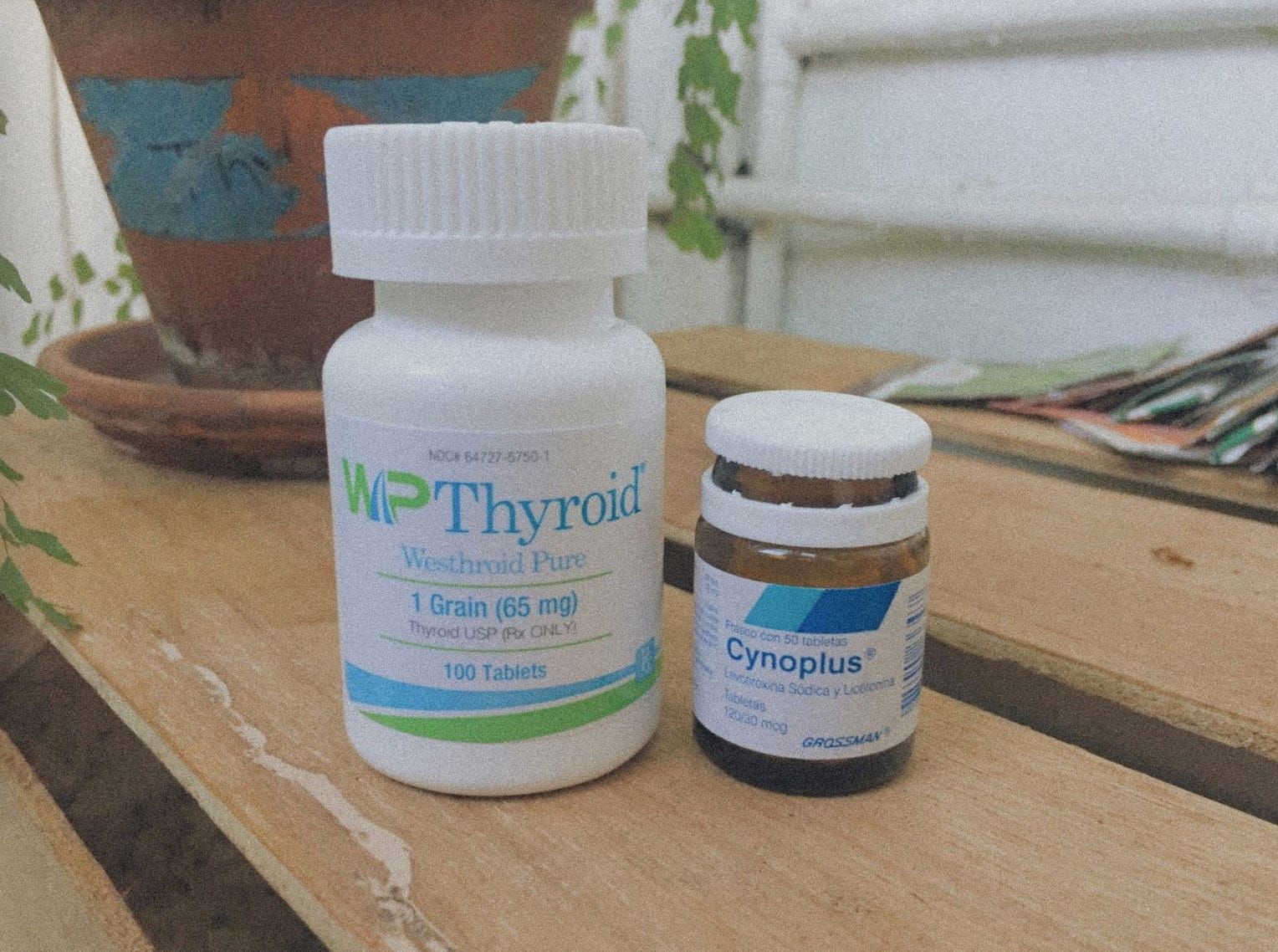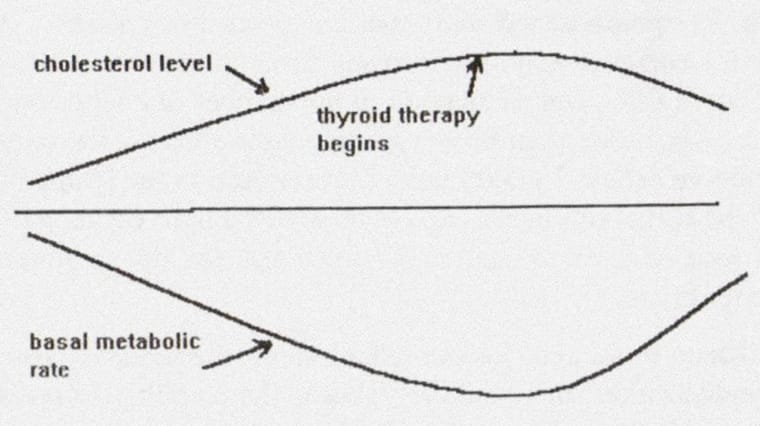Demystifying Thyroid Supplementation by Danny Roddy
-
This article along with a couple others are gone from Danny's substack so I decided archive it here for everyone.

Originally posted October 2017.
[New 2022] Common Thyroid Mistakes: https://t.me/dannyroddy/915
[New 2023] Bioenergetic Basics #1: Successfully Using a Thyroid Supplement of
T3 and T4 https://dannyroddy.substack.com/p/bioenergetic-basics-1-successfullyContinuing the trend of concretizing some thoughts on popular questions, I
wanted to put together a little "thyroid primer." For clarity, I've split this post into
three sections: 1) symptoms, 2) determining the correct dose, 3) T3/T4 ratio, and 4)
troubleshooting. Please ask questions below if something is not clear or I left
something out.Part I: Symptoms
“Oral or armpit temperature, in the morning before getting out of bed, should be
around 98F, and it should rise to 98.6F by mid-morning... Healthy populations have
an average resting pulse of about 85 per minute. Especially in hot weather it is useful
to consider both temperature and pulse rate.” — Ray Peat“The proper dosage for any individual is the minimum needed to relieve symptoms.
Most commonly, in adults, this is two grains; three grains sometimes are needed.
rarely four grains may be required. The basal temperature may still be a little low,
but one is treating symptoms, not temperature per se.” —Broda BarnesIn addition to grabbing the resting pulse rate and underarm temperature in the
morning and afternoon, it's probably good to become familiar with the classical
low thyroid symptoms. Here is a shortlist from a 1981 paper by James, et al.
While I can identify with many symptoms on that list, famous "thyroidologist"
Broda Barnes pointed out that people express symptoms differently, which is why
the pulse rate and temperature are so valuable as health markers in times of
uncertainty:“No single symptom has been found which would apply to every person with low
metabolism. Some have fatigue, some have cutaneous disorders, some have dry
skin, some have nervousness, some have menstrual difficulties, some have dry hair
and some have other symptoms, but none of these signs could be considered reliable
in all cases.” — Broda Barnes
Image: Thyroid supplementation before and afterPart II: Determining The Right Dose
“When doubt exists, a trial of thyroid supplementation may be the most useful
diagnostic tool.” — M.B. James (1981)“A therapeutic trial was the final test of the validity of the diagnosis: If the patient's
symptoms disappeared as his temperature and pulse rate and food intake were
normalized, the diagnostic hypothesis was confirmed... Whatever objective
indicator was used, whether it was basal metabolic rate, or serum cholesterol, or
core temperature, or reflex relaxation rate, a simple chart would graphically indicate
the rate of recovery toward normal health.” — Ray Peat“...An eighth to a fourth of a [Cynoplus] tablet would be a reasonable amount to
start with; thyroxine’s half-life in the body is two weeks, so the effect is cumulative, and if you get the desired effects in less than two weeks the dose
should probably be reduced.” — Ray Peat“It’s best to absorb it slowly, to imitate the normal pattern of secretion, and food
helps to slow the absorption.” — Ray Peat“Sensitivities and requirements vary widely. I've known people who temporarily
needed 500 mg of Armour even in the summer, but usually the summer requirement
is a fourth of the winter requirement. For some people, 15 mg of Armour was
enough, and for some 1 mcg of Cytomel was an effective dose.” — Ray PeatIf a person feels like they have a general understanding of the problem they're
experiencing along with what thyroid therapy has to offer, I don't think it's
unreasonable to investigate obtaining thyroid hormone. Usually, people get
thyroid hormone from their doctors, although some people purchase it from
online pharmacies, for example, here and here.Thyroid hormone is measured in “grains” with one grain being about ~12.5
micrograms of T3 and ~50 micrograms of T4. A healthy person usually makes
about four grains of thyroid per day.- One grain of thyroid = 12.5 micrograms of T3 and 50 micrograms of T4
- One cynoplus tablet = 30 micrograms of T3 and 120 micrograms of T4 (or 2.2
grains)
Broda Barnes noted that his patients usually needed about two grains:
“Most commonly, in adults, this is two grains [to correct hypothyroid symptoms];
three grains sometimes are needed, rarely four grains may be required.” — Broda
BarnesWhen I asked Ray in 2014 if a person ever needed more than two grains, he
replied:“In general, no, but I have known a few people who needed much larger amounts for
a while.” — Ray PeatIf the body only makes a few micrograms of T3 per hour, it’s critical to not
take more than 5-10 micrograms of T3 per dose (with food):“...Each dose shouldn't contain much more than maybe 10 mcg of T3. If you're
going to take say 10 mcg of Cytomel and 40 mcg of T4 then you should break it so
that each dose doesn't give you much more than 10 mcg of T3.” Ray PeatBesides taking a slow and methodical approach, something I think that is very
important to remember is that the half-life of T4 (thyroxine) is two weeks, and thus
the full potential of any given dose isn't 'realized' until the end of the second week.I've talked to many people who told me that they changed their thyroid dose every few days, which I imagine makes things ridiculously confusing, if not impossible, to figure out. Whatever the dose, it should be maintained for at least two weeks
before judging the effects.Part III: T3/T4 Ratio
While Broda Barnes treated his patients with the standard 1:4 ratio of T3:T4,
something unique about Ray Peat is his emphasis on T3. For example, in the
article, Thyroid: Therapies, Confusion, and Fraud, Ray mentions that a 1:3 ratio of
T3:T4 is “brain favorable”:“These observations suggest to me that the blood’s T3:T4 ratio would be very 'brain
favorable' if it approached more closely to the ratio formed in the thyroid gland, and
secreted into the blood. Although most synthetic combination thyroid products now
use a ratio of four T4 to one T3, many people feel that their memory and thinking
are clearer when they take a ratio of about three to one. More active metabolism
probably keeps the blood ratio of T3 to T4 relatively high, with the liver consuming
T4 at about the same rate that T3 is used.” — Ray PeatIn practice, this usually means adding additional T3 in the form of Cynomel to the
dose of Cynoplus or another combination thyroid brand. For example, for myself, I
usually take small amounts of T3 during the day and save the combination product
(T3 and T4) for the evening.Part VI: Troubleshooting
“One mistake which has been made in the past has been to start thyroid therapy with
excessive amounts. Another has been to give up too soon to expect immediate
results, immediate disappearance of symptoms. And still a third has been to stop
thyroid therapy because the patient has become nervous and the nervousness has
been thought to be the result of too much thyroid. If the basal temperature is still
low or within the normal range, it is a clear indication that the nervousness and
other symptoms are not coming from too much thyroid and thyroid therapy
should continue while an effort is made to overcome or adjust to what is really
the disturbing factor.” — Broda Barnes (1973)“That sort of sudden adrenaline effect can happen when there’s something
essential missing in the diet, while the requirements are increased by using
thyroid. Deficiencies of protein, magnesium, calcium, and the B vitamins are most
likely. Too much phosphate and too little carbohydrate are other possibilities.” …
“When you first start taking thyroid again, your tissues will need some extra
magnesium...” — Ray Peat“Administration of thyroid to these patients, in the absence of a vitamin B
supplement, usually caused exacerbation of the signs and symptoms of
deficiency without significant change in the metabolic rate.” — Morton Biskind
(1946)With the general understanding that thyroid is an effective broad-range therapy
with a long historical track record of safety, a person can start thinking about
potential possibilities if thyroid therapy does not go as expected. Some of the most
common road bumps seem to be:- Vitamin D deficiency
- A diet deficient in protein or B vitamins
- A diet deficient in calcium and excessive in phosphate
- A diet deficient in carbohydrate
- A diet deficient in calories
- Ruminant liver-avoidance
- Oyster-avoidance
- Infection, which is more common in hypothyroid people
- Cholesterol deficiency (requires a lab test)

One of the reasons I'm bullish on finding a way to regularly consume liver and
oysters is that increasing the rate of metabolism can quickly increase a person's
nutritional needs. I think attempting to replicate the nutrition found in liver and
oysters with supplements is a fool's errand with each new supplement introduced
as a possible allergen. Vitamins D and K can be safely used topically as Ray and I
talk about in this interview.“When your intestine is extremely sensitive, the excipients and contaminants in a
pregnenolone tablet could cause bad symptoms; the only supplements that are
very safe to take orally are aspirin, cascara, some kinds of thyroid, small
amounts of penicillin (30 mg), cyproheptadine (one half to one milligram), and
progesterone. Vitamin A and DHEA on the skin are safe, but you should put the vitamin A on your lower legs, and wash your hands so that none of it gets on your
lips.” — Ray PeatPart V: Final Thoughts
A final consideration with using a thyroid supplement is a person's climate. For
example, while I need about 1/4 of a Cynoplus tablet and some extra T3 while I'm
in Mexico, I needed almost an entire Cynoplus tablet when I visited cold Japan.Also, for what it's worth, I've been using cynoplus and cynomel since about 2011
and still feel like I'm learning new things about them. For myself, incorporating
thyroid was tricky due to an infection and extreme malnourishment (after two
years of zero-carb), but the journey to respond to thyroid normally revealed several
other problems that I wouldn't have known about otherwise.I hope this helps. Cheers.
-
 K Kvirion referenced this topic on
K Kvirion referenced this topic on
-
This post is deleted!